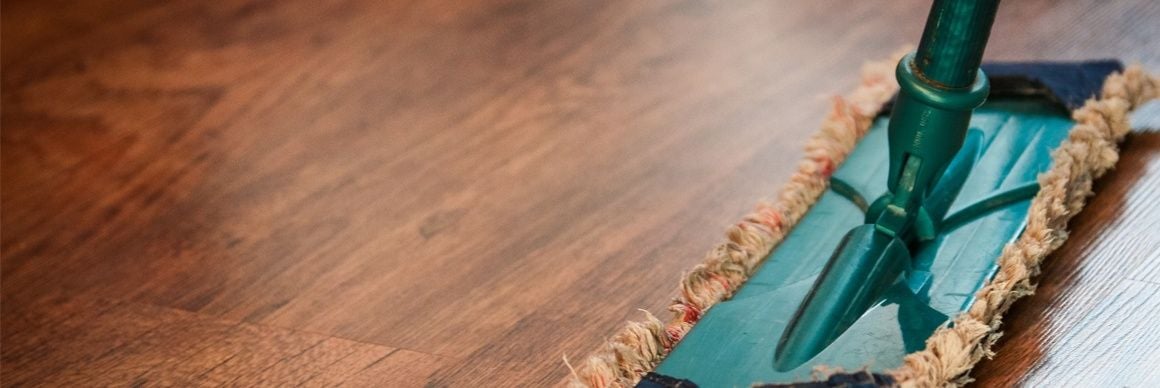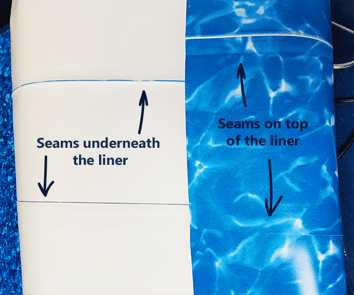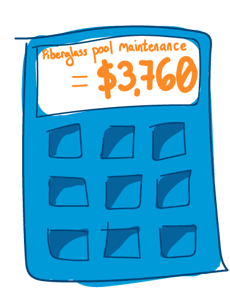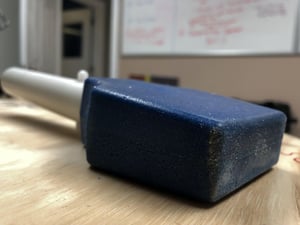
When I'm doing the dishes, I love the dishwasher-safe ones. I just pop 'em in the dishwasher, run the wash cycle, and move along until they're clean. So easy!
Hand-wash-only dishes feel ridiculously high-maintenance in comparison. As I scrub them, I hate them. Sorry, Abraham Lincoln mug.
Cleaning dishes is nothing compared to cleaning a pool. How can you make sure your pool is "dishwasher safe"—as low maintenance as it can possibly be?
The TYPE of pool you have can make or break your maintenance satisfaction. The interior finish, durability, and more can significantly increase or decrease your to-do list (and your costs).
Here at River Pools, we specialize in fiberglass pools, but we know that all 3 pool types have a place in the market. There are pros and cons to each!
Maintenance is only one aspect of that, but it can make a big difference in your long-term pool satisfaction.
Even if maintenance time and cost doesn't bother you, it's an aspect to consider. We want to let you know about all expenses you'll need to account for, so that you can make the best decision for you and your family.
Which pool type has the lowest maintenance?
Concrete pools need the most maintenance of all 3 types, and it can be very expensive ($27,400 over 10 years). Vinyl liner pools need a little less, so the maintenance costs less ($11,500 over 10 years). Fiberglass pools need the least maintenance, and they cost the least ($3,750 over 10 years).
Concrete pool maintenance
Concrete pools require the most maintenance of all three pool types. This doesn't make them bad! But you do need to take its needs into consideration.
- Maintaining the water chemistry
- Weekly steel brushing
- Acid washing
- Refinishing
- Professional pool cleaning service each year (for many concrete pool owners)
- Algae grows easily and keeps coming back
- Filter needs two circulations per day
Maintaining the water chemistry
Each week you need to check that the pool chemistry levels are in the ideal ranges:
- Total alkalinity: 80–120 ppm
- pH: 7.2–7.8
- Calcium hardness: 200–400 ppm
- Stabilizer (cyanuric acid): 20–50 ppm
- Chlorine: 2.0–3.0 ppm
Plaster surfaces need the most TLC of all interior finishes. The alkaline finish affects the water pH, so you have to work harder to keep the water stats in the ideal range.
Every pool type needs a weekly water checkup, but concrete pools do best when you add acid daily.
Scrubbing with a steel brush for algae
Plaster is also super porous. Hellooo, algae.
Normally I'm all about nature and greenery, but not so much when it's in the pool.
To keep your concrete pool walls clean, you need to scrub them with a steel brush each week. The steel brush gets in the nooks and crannies to brush out any algae that might be growing there.
Sad fact: once algae gets in your pool surface, it'll keep coming back. It's insidious that way, like an ex-boyfriend who keeps calling even though you told him not to.
A tile interior finish is nonporous, so you don't have the algae problem. However, tile is super expensive as a pool surface, and if you wait too long to resurface, they'll start falling off.
Acid washing a concrete pool
Every 3–5 years, your concrete pool needs a professional acid wash.
This removes a thin layer of the plaster and penetrates the pores to kill algae and remove stains.
The process requires a gas mask that looks like it's straight out of World War II. I wish I were joking.
The exact cost of a professional acid wash depends on the pool size, location, accessibility, and time of year. It's usually around $450.
Refinishing a concrete pool
Yep, resurfacing. This is the concrete pool equivalent of replacing a liner, only worse.
Every 10–15, perhaps 20 years, you need to redo the entire surface of a concrete pool. Plaster gets faded and gross-looking, plus algae forms. The pebbles in exposed aggregate pop off. Tile gets scummy and falls off.
It costs $10,000 or more, which isn't pretty.
"I don't NEED to resurface my concrete pool!" people complain. "That's a waste of money!" So they don't resurface, and then they complain that their concrete pool looks bad. Gee, I wonder why.
Professional cleaning service
Does this sound exhausting? You're not alone.
Many concrete pool owners choose to hire a professional pool cleaning service each swim season.
That's perfectly valid! It saves them the time and effort of doing it themselves.
But bear in mind, a pro costs about $500.
Running the filter system
Your pump and filter system has to work pretty hard on a concrete pool.
Two circulations (or turnovers) per day keeps the water looking good. (For contrast, a vinyl liner pool or fiberglass pool only needs one circulation.)
On top of that, let's say you open your pool in the spring and find all sorts of nastiness. You may not need to shock the pool. But if you do, it can take a week or more for it all to clear up. Sad.
Vinyl liner pool maintenance
Vinyl liner pools need a moderate amount of maintenance—less than a concrete pool, but more than a fiberglass pool.
- Maintaining the water chemistry
- Liner leaks
- Liner replacements
- Algae grows in seams of steps/walls and places with no circulation
- Filter needs one circulation per day
Maintaining the water chemistry
Each week you need to check the chemistry levels:
- Total alkalinity: 80–120 ppm
- pH: 7.2–7.8
- Calcium hardness: 200–400 ppm
- Stabilizer (cyanuric acid): 20–50 ppm
- Chlorine: 2.0–3.0 ppm
 Liner leaks
Liner leaks
Liners are super thin—about as thick as 10 sheets of paper. You gotta be super careful not to puncture or rip them. Keep Fluffy off the steps and tanning ledge.
Pro tip: use your pool cover to keep out any stray landscaping or even stray animals. We've even heard of deer falling in.
Vinyl liners can leak at the seams or at tiny punctures from dog claws or tree branches.
If you have metal wall panels (steel or aluminum, usually), the leaking water can rust/corrode the panel. If it goes on long enough, it can create an actual hole, meaning you'll need to replace the wall panel altogether. No thanks.
Replacing the liner
The biggest part of vinyl liner pool maintenance is in the long term. After 5–9 years, you'll have to replace the liner. That's expensive and difficult.
You can spare yourself some of that difficulty by hiring a professional to do the work, but your costs will go up.
Conversely, you can save some money by doing the job yourself, but it is insanely hard to get the liner lined up exactly. We recommend you hire a professional.
Algae is unlikely but possible in certain areas
The liner itself is fairly nonporous, so you're unlikely to get algae on the pool walls and floor.
However, watch out for the little corners, seams, and in the nooks and crannies of the plastic pool stairs where there's poor water circulation. Algae can develop there and never be seen....little creepy.
Running the filter system
Because the liner doesn't summon algae, you don't have to work as hard cleaning the walls and water.
One circulation per day (about 7 hours, usually) will keep your pool looking good.
And if your vinyl pool is really dirty, it will likely take 3–4 days to clear up. That's significantly faster than a concrete pool, but several days slower than a fiberglass pool.
Fiberglass pool maintenance
Fiberglass pools need the least maintenance of the three pool types.
- Maintaining the water chemistry
- Algae isn't a problem
- Filter needs one circulation per day
If manufactured well and maintained properly, a fiberglass pool’s gelcoat should never need to be refinished.
Maintaining the water chemistry
You guessed it!
Each week you need to check that the chemistry levels are in the ideal ranges:
- Total alkalinity: 80–120 ppm
- pH: 7.2–7.6
- Calcium hardness: 150–200 ppm
- Stabilizer (cyanuric acid): 30–50 ppm
- Chlorine: 1.0–3.0 ppm
Algae: not a problem
The gelcoat surface is smooth and algae-resistant, and there aren't any little seams, so algae has nowhere to dig its ugly little fingers in.
So hey, nice—you're unlikely to get algae as long as you keep up your routine maintenance.
Bonus: you don't have to slave over your pool to do so. No steel-brushing and acid washing here.
Running the filter system
The filter doesn't have to work hard either. You'll only need one circulation per day to keep your water clear and your pool clean.
That'll be about 7 hours for the average fiberglass pool, although it depends on your pool volume and the filtration rate on your system.
Say you open your pool in the spring, and boo, winter didn't treat it well. Dirt, leaves, unwanted greenery…not to worry.
Most fiberglass pools, even completely covered in algae, will clear up within 24 hours with super-chlorination, algaecide, and regular cleaning/backwashing of the filter.
Pool maintenance costs
As you might expect, pool maintenance costs rise with the intensity and amount of maintenance needed.
For any of the 3 pool types, the exact costs depend on multiple factors:
- the pool
- the location
- the overall maintenance quality
- the position of the stars (well, maybe not that one)
These are just approximations, but on average, this is what you should save in your piggy bank.
 How much does concrete pool maintenance cost?
How much does concrete pool maintenance cost?
Concrete pools need a lot. Acid washing and refinishing are both hardcore and therefore cost a pretty penny. Acid washing is $450 every 3–5 years; refinishing is $10,000 every 10–15 years.
If you want a professional cleaning service, that'll hit your bank account too ($500/season).
You pay for extra chemicals ($750/year) and electricity ($400/year) because of the surface alkalinity and the double circulations.
Over 10 years, concrete pool maintenance will come out around $27,400.
 How much does vinyl liner pool maintenance cost?
How much does vinyl liner pool maintenance cost?
Vinyl liner pools have less than half those costs!
The liner won't be acid washed, only brushed weekly to clear off dirt and scum.
You only need one circulation per day, and the liner doesn't chemically interact with the water, so your electric and chemical costs are lower ($300/year and $400/year, respectively).
Your biggest cost is in replacing the liner every 5–9 years. That's about $4,500.
So vinyl liner pool maintenance over 10 years is about $11,500.
 How much does fiberglass pool maintenance cost?
How much does fiberglass pool maintenance cost?
Fiberglass pools need the least long-term maintenance, so they cost the least!
Your only real costs are water chemicals ($175/year) and electrical energy for the pump and filter system ($200/year).
Fiberglass pool maintenance over 10 years costs about $3,750.
Pool maintenance summary
Like a house or car, your pool needs regular maintenance to look and function its best. If you keep up with it, the work is quick and easy. And if you have a fiberglass pool, the work is even simpler.
We want to help you, and we provide all the information so you can make the best decision for you and your family. You can look over the basics of fiberglass pools if you aren’t familiar with them and compare all three pool types.
River Pools works through independent installers throughout North America who install our pools. If you're ready to take the next step in creating your dream backyard, get in touch with an installer near you!
Up Next:
The Ultimate Guide To Inground Swimming Pool Maintenance
What Maintenance Does a Fiberglass Pool Need?
Editor's note: This article was updated on November 21, 2023.
Topics:



